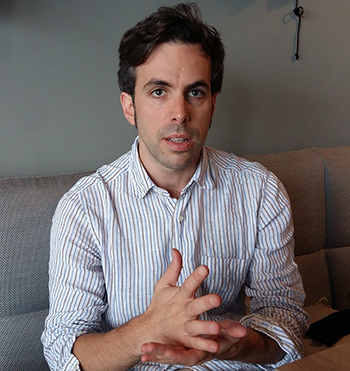
Eric Le Bourhis
For many survivors of the Holocaust, persecution began in the hometown, where greed may have swayed perceived friends and neighbors to unspeakable actions. The inhabitance of formerly Jewish-owned apartments by non-Jewish tenants in the early 1940s, specifically in Paris, provides a strong case study of this phenomenon and the basis of a research project developed by Eric Le Bourhis of the Institute for Political Sciences, Nanterre (France).
By crossing administrative files like rental agreements with both the archives of the racial persecution of the time and the ones of ordinary urban life, Bourhis and his research team have been able to study the local dynamics of the Holocaust in Paris, looking at the relationships between Jewish and non-Jewish populations and the spatial presence of Parisian Jews in 1942.
He’ll present his team’s findings based on a geographical information system they developed in October at USC Shoah Foundation’s 2017 International Conference “Digital Approaches to Genocide Studies,” co-sponsored by the USC Mellon Digital Humanities Program. The two-day conference, which will be held at the University of Southern California in Los Angeles, invited scholars from across the globe to converge and discuss the relationship between digital methodologies, practices, ethics and the nature of contemporary Holocaust and Genocide Studies.
“[Our presentation] will plead for a digital geographical approach to the Holocaust,” Bourhis and research partner Sarah Gensburger of the French National Center for Scientific Research wrote in their topic proposal. “It will state its hope to renew this research field through the study of the housing policies and homes transfers during the war.”
Bourhis has long focused his studies on urban history and the history of housing. Last year, he was awarded the French Society for Urban History’s special prize for best dissertation on the subject, a nomination from the Association for the Advancement of Teaching and Research Planning and Urbanism for best dissertation. He’s also largely found success in his work preserving and studying the memory of the Holocaust, earning a post-doc fellowship from the Foundation for the Memory of the Shoah and several other awards.
The scholar – who received his Ph.D. in History at the School for Advanced Studies in the Social Sciences in Paris – will join over a dozen others presenting on a variety of subjects at the conference, from the netnography of digital autobiographical documentary to the capacities of geographic information systems for analyzing Holocaust spaces to the usefulness of augmented reality technologies in sharing the memories of the places of genocide.
In an initial call for papers, USC Shoah Foundation asked academics to investigate the ways in which digital tools and methods, new media and information technologies can help us to challenge conventional wisdom regarding the Holocaust and Genocide Studies by raising new questions, improving our understandings, deepening our analyses, widening our fields of view and pioneering new approaches.
“The many archival materials we found inspired us to develop quantitative and digital tools to go further into the research,” Bourhis said. “The point of our work in regards to digital humanities was to develop a method to integrate the transformation of raw archival materials into data and the examination of data using digital tools – that is, to reconnect intellectual operation that are often separate.”
For Bourhis and his team, their research has only proven that the spatialisation of the past is a powerful tool for the curation and transmission of the social history of the Holocaust. Thus far, it has given birth to a digital sound-walk called People of the Holocaust, currently under production to tell the stories of former inhabitants of homes from their perspectives in the places the events took place.
“People of the Holocaust calls on the imagination and emotion of today’s visitors in order to bring these former Parisians back to life,” according to their presentation proposal. “The presentation at the conference will come back to the creation process – from the use of digital tools to foster the spatial dimensions of the research to the curation of some of its outputs, mobilizing some additional digital tools.”
At the conference, Bourhis looks forward to reviewing his materials with other scholars and engaging further with USC Shoah Foundation, whose Visual History Archive – a collection of over 54,000 digitized and fully searchable video testimonies from survivors and other eyewitness of the holocaust, the Rwandan, Guatemalan and Armenian genocides and the Nanjing Massacre in China. Both entities – Bourhis is familiar with.
After, Bourhis and his team may develop a long-term project on housing requisitions between the 1930s and 1940s in European cities on a comparative basis.